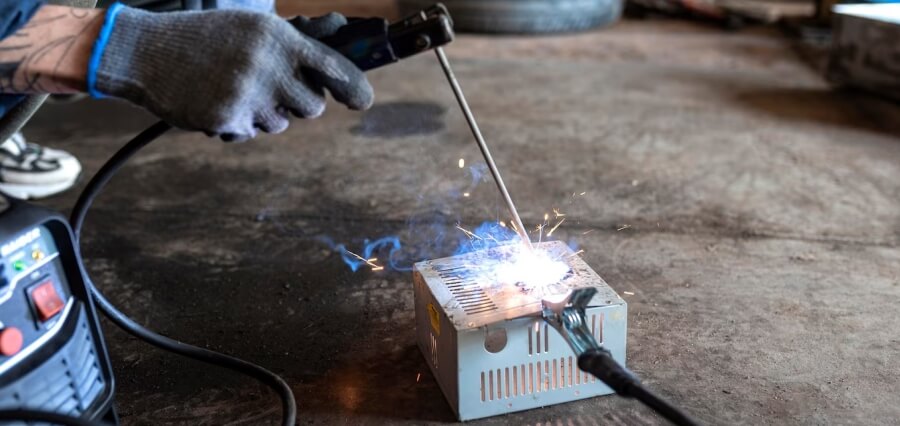In any industry, it is crucial to prioritize safety. This principle holds true for the field of welding as well. Welders often face health risks due to the emission of fumes during welding tasks. These fumes contain substances like metal oxides, ozone, and volatile organic compounds (VOCs).
Prolonged inhalation of these fumes can lead to long-term health complications such as issues, cardiovascular conditions, and even certain types of cancer. In this blog, we unravel the critical importance of workplace safety in welding operations, spotlighting the indispensable role played by fume extractors.
Understanding Fume Extractors
A welding fume extractor plays a role in safeguarding both the welders’ well-being and maintaining a work environment overall. Its primary function is to remove fumes generated during welding processes, ensuring that clean and breathable air circulates within the workspace.
Fume extractors operate by utilizing hoods or arms that suction or pull in the air near their source. This contaminated air then undergoes filtration processes designed explicitly to capture particles before releasing the air back into the surrounding area.
Advantages of Employing a Fume Extractor
Shielding Against Health Hazards
The advantage brought about by having a fume extractor installed at every welding station is its significant reduction in workers’ exposure to harmful fumes. By avoiding the inhalation of substances, welders can protect themselves from health risks associated with welding fumes. This has an impact on their respiratory health both in the short term (such as by reducing coughing) and in the long term by preventing chronic illnesses.
Adherence to Safety Regulations
Industries that deal with materials or processes like welding are required to follow safety regulations imposed by the government. Non-compliance can have consequences for businesses operating in these sectors. Therefore, implementing a fume extraction system not only ensures compliance but also demonstrates a commitment to the rules and guidelines set by local health and safety authorities.
Improved Visibility & Efficiency During Welding
In addition to safeguarding workers’ well-being, fume extractors also enhance the efficiency and productivity of welding operations. Maintaining a dust-free environment around the welding area achieves optimal visibility during the process. This enables welders to work without distractions, resulting in high-quality welds completed within timeframes.
Enhanced Air Quality
The installation of fume extractors also contributes to improved air quality within the workplace. During welding processes, harmful fumes, along with particles and smoke generated from melting metals, are released into the air. These pollutants can easily pose risks to employees near the welding station.
When businesses utilize a fume extractor, they can create a safe working environment for everyone while also reducing the chances of employees complaining about air quality.
Choosing the Appropriate Fume Extractor
When deciding on a fume extractor for a welding station, there are several important factors to consider:
Capacity and Efficiency of the System
The size of the welding station and its workload determine the necessary capacity and efficiency levels of the extraction system. It is essential to select an extractor that meets or exceeds the recommended extraction rates for welding processes in terms of cubic feet per minute (CFM).
Filtration Method
Different types of fumes produced by welding materials like steel, aluminum, or mild steel require filtration methods. Make sure that your chosen fume extractor utilizes filters for the materials used in your facility.
Portable vs. Stationary Models
Consider whether portability is necessary for your workflow and whether you need units throughout your workspace or one central unit.
Maintenance Tips for Fume Extractors
To ensure performance and prolong the lifespan of your fume extractor investment, follow these maintenance tips:
Regular Replacement of Filters
Filters play a role in effectively capturing harmful particles; however, their effectiveness diminishes over time as they become saturated with pollutants. Create a schedule for replacing filters based on the type of filter and the intensity of workload to ensure extraction efficiency.
Cleaning & Inspection
Regularly clean the components of the extractor to remove any dust or debris that may affect its performance. Additionally, conduct inspections of all parts and connections to identify any signs of wear or damage.
Staff Training
Staff training in using the fume extractor is essential for its operation and maximizing its benefits. Educate welders about usage, maintenance procedures, filters, and any specific safety precautions associated with your chosen model.
Conclusion
In conclusion, it is crucial to provide a fume extractor at each welding station to ensure workplace safety, protect worker health, comply with safety regulations, enhance visibility and efficiency during welding processes, and improve air quality within the facility. By selecting a fume extractor system and following recommended maintenance practices, businesses can prioritize their workforce’s well-being while optimizing productivity in welding operations.


